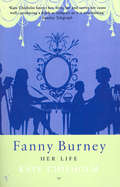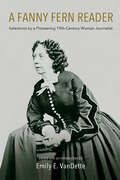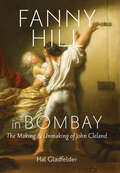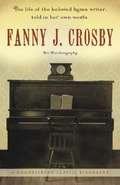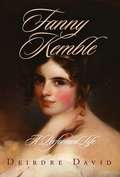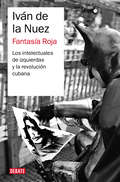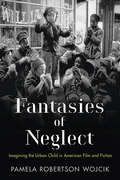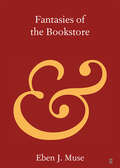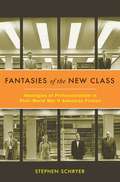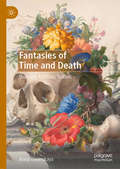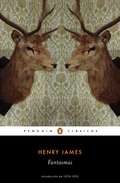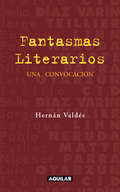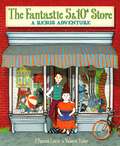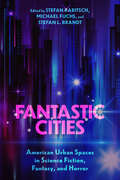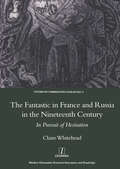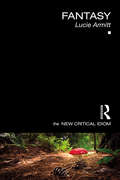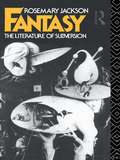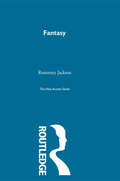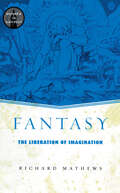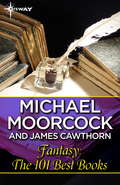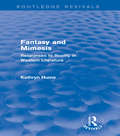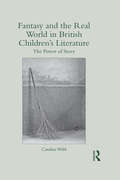- Table View
- List View
Fanny Burney: Her Life
by Kate ChisholmFanny Burney (1752-1840) is best known as the author of EVELINA, one of the most engaging novels of the eighteenth century. But for much of her long life, she was also an incomparable diarist, witnessing both the madness of George III and the young Queen Victoria's coronation. To read the journals she kept from the age of sixteen is to step back into Georgian England, meeting Dr Johnson, Garrick and Reynolds, being chased round the gardens of Kew Palace by the King. . . She was lady-in-writing to Queen Charlotte; she married an aristocratic emigre from the French Revolution and had her first and only child when she was forty-two; she was in Paris as Napoleon's armies marshalled against England, and in Brussels she heard the muffled guns, and watched the wounded being carried back from Waterloo. Kate Chisholm's delightful biography, incorporating the latest research and illustrate with unusual portraits and drawings, is lively, funny, shocking, informative and deeply moving; it paints a vivid portrait of a woman of great talent, against the changing background of England and France, a culture and an age.
A Fanny Fern Reader: Selections by a Pioneering Nineteenth-Century Woman Journalist
by Fanny FernIn the middle of the nineteenth century, the highest paid and most famous newspaper writer in the US was a woman known to the world as Fanny Fern, the nom de plume of Sara Payson Willis. A Fanny Fern Reader features a selection of Fern's columns, mostly from her years as a weekly columnist for the New York Ledger, along with an introduction that shares the remarkable story of Fern's perseverance and success as a woman in a male-dominated profession. For readers in her own time, Fern's frank and unbridled social commentary and boldly satirical voice made her a household name. Fern's subversive and witty commentary about social mores, gender roles, childhood, authorship, and family life transcend time and continue to resonate with and entertain readers today. A Fanny Fern Reader is the most extensive collection of Fern's newspaper writings to date and includes several works that have been out of print for over a century, making this author's writing on a wide range of issues accessible for readers within and outside of classrooms and academic settings.
Fanny Hill in Bombay: The Making and Unmaking of John Cleland
by Hal GladfelderJohn Cleland is among the most scandalous figures in British literary history, both celebrated and attacked as a pioneer of pornographic writing in English. His first novel, Memoirs of a Woman of Pleasure, or Fanny Hill, is one of the enduring literary creations of the eighteenth century, despite over two hundred years of legal prohibition. Yet the full range of his work is still too little known.In this study, Hal Gladfelder combines groundbreaking archival research into Cleland’s tumultuous life with incisive readings of his sometimes extravagant, sometimes perverse body of work, positioning him as a central figure in the development of the novel and in the construction of modern notions of authorial and sexual identity in eighteenth-century England.Rather than a traditional biography, Fanny Hill in Bombay presents a case history of a renegade authorial persona, based on published works, letters, private notes, and newly discovered legal testimony. It retraces Cleland’s career from his years as a young colonial striver with the East India Company in Bombay through periods of imprisonment for debt and of estrangement from collaborators and family, shedding light on his paradoxical status as literary insider and social outcast.As novelist, critic, journalist, and translator, Cleland engaged with the most challenging intellectual currents of his era yet at the same time was vilified as a pornographer, atheist, and sodomite. Reconnecting Cleland’s writing to its literary and social milieu, this study offers new insights into the history of authorship and the literary marketplace and contributes to contemporary debates on pornography, censorship, the history of sexuality, and the contested role of literature in eighteenth-century culture.
Fanny Hill in Bombay: The Making & Unmaking of John Cleland
by Hal GladfelderA study of the life and work of the notorious English novelist.John Cleland is among the most scandalous figures in British literary history, both celebrated and attacked as a pioneer of pornographic writing in English. His first novel, Memoirs of a Woman of Pleasure, or Fanny Hill, is one of the enduring literary creations of the eighteenth century, despite over two hundred years of legal prohibition. Yet the full range of his work is still too little known.In this study, Hal Gladfelder combines groundbreaking archival research into Cleland’s tumultuous life with incisive readings of his sometimes extravagant, sometimes perverse body of work, positioning him as a central figure in the development of the novel and in the construction of modern notions of authorial and sexual identity in eighteenth-century England.Rather than a traditional biography, Fanny Hill in Bombay presents a case history of a renegade authorial persona, based on published works, letters, private notes, and newly discovered legal testimony. It retraces Cleland’s career from his years as a young colonial striver with the East India Company in Bombay through periods of imprisonment for debt and of estrangement from collaborators and family, shedding light on his paradoxical status as literary insider and social outcast.As novelist, critic, journalist, and translator, Cleland engaged with the most challenging intellectual currents of his era yet at the same time was vilified as a pornographer, atheist, and sodomite. Reconnecting Cleland’s writing to its literary and social milieu, this study offers new insights into the history of authorship and the literary marketplace and contributes to contemporary debates on pornography, censorship, the history of sexuality, and the contested role of literature in eighteenth-century culture.“Cleland’s life story is a puzzle with many pieces still missing. But Gladfelder’s careful, painstaking reconstructions have brought the fascinating picture into much clearer focus.” —Choice“Anyone interested in the history of pornography or Cleland cannot afford to be without this study of the writer and his work.” —Julie Peakman, Times Literary Supplement (UK)“Innovative, adventurous, and exciting. Gladfelder has given us a new and, for eighteenth-century studies, a newly significant and central John Cleland—a writer whose notoriety as author of the first pornographic novel in English has until now overshadowed a long, varied, and remarkable career as colonial administrator, projector, jailbird, bookseller’s hack, alleged sodomite, translator, reviewer, philologist, and author of numerous original works beyond the Memoirs. . . . An exemplary—an unusual and immensely enabling—combination of painstaking archival and other historical research and analytic, expository flair. The scholarship is formidable throughout.” —Thomas Keymer, University of Toronto
Fanny J. Crosby: An Autobiography (Hendrickson Classic Biographies Series)
by Fanny J. CrosbyThe memoirs and observations of the composer of over eight thousand hymns. Stories from her entire life from her blindness as an infant through her old age. Fanny Crosby was friends with famous people the world over including several presidents. She tells her story with love and compassion.
Fanny Kemble
by Deirdre DavidA ForeWord magazine Book of the Year for 2007Charismatic, highly intelligent, and splendidly talented, Fanny Kemble (1809-93) was a Victorian celebrity, known on both sides of the Atlantic as an actress and member of the famous Kemble theatrical dynasty, as a fierce opponent of slavery despite her marriage to a wealthy slave owner, as a brilliantly successful solo performer of Shakespeare, and as the author of journals about her career and life on her husband's Georgia plantations. She was, in her own words, irresistible as a "woman who has sat at dinner alongside Byron . . . and who calls Tennyson, Alfred."Touring in America with her father in the early 1830s, Kemble impulsively wed the wealthy and charming Philadelphia bachelor Pierce Butler, beginning a tumultuous marriage that ended in a sensational divorce and custody battle fourteen years later. At the time of their marriage, Kemble had not yet visited the vast Georgia rice and cotton plantations to which Butler was heir. In the winter of 1838, they visited Butler's southern holdings, and a horrified Kemble wrote what would later be published on both sides of the Atlantic as Journal of a Residence on a Georgian Plantation. An important text for abolitionists, it revealed the inner workings of a plantation and the appalling conditions in which slaves lived. Returning to England after her divorce, she fashioned a new career as a solo performer of Shakespeare's plays and as the author of memoirs, several travel narratives and collections of poems, a short novel, and miscellaneous essays on the theater. For the rest of her life, she would divide her time between the two countries.In the various roles she performed in her life, on stage and off--abolitionist, author, estranged wife--Kemble remained highly theatrical, appropriating and subverting nineteenth-century prescriptions for women's lives, ever rewriting the roles to which she was assigned by society and inheritance. Hers was truly a performed life, and in the first Kemble biography in twenty-five years to examine that life in its entirety, Deirdre David presents it in all its richness and complexity.
Fantasía roja
by Iván de NuezUn repaso ácido e inteligente a la visión de muchos intelectuales europeos y americanos por el gobierno de Fidel Castro. ¿Qué tienen en común Jean-Paul Sartre y Oliver Stone, Régis Debray y Sydney Pollack, el músico Ry Cooder, que dio a conocer Buena Vista Social Club, y el director de cine Richard Lester, que dirigió a los Beatles, Giangiacomo Feltrinelli y Max Aub, Graham Greene y David Byrne? Además de ser o haber sido, cada uno a su manera y condición, reconocidos iconos intelectuales de la izquierda occidental, estos ilustres personajes han compartido su pasión por la Revolución cubana. A desentrañar las causas, profundas o banales, de esa pasión está dedicado Fantasía roja, un ensayo personal escrito con tanta profundidad conceptual como sentido del humor. Desde la filosofía o la música, la novela o el cine, el fuego y la ruina, el turismo y los desvencijados Cadillac, la teoría y la calle, este estudio indaga los misterios de esa fantasía y propone un debate sobre qué cabría esperar de una izquierda renovada para el siglo XXI.
Fantasies of Neglect
by Pamela Robertson WojcikIn our current era of helicopter parenting and stranger danger, an unaccompanied child wandering through the city might commonly be viewed as a victim of abuse and neglect. However, from the early twentieth century to the present day, countless books and films have portrayed the solitary exploration of urban spaces as a source of empowerment and delight for children. Fantasies of Neglect explains how this trope of the self-sufficient, mobile urban child originated and considers why it persists, even as it goes against the grain of social reality. Drawing from a wide range of films, children's books, adult novels, and sociological texts, Pamela Robertson Wojcik investigates how cities have simultaneously been demonized as dangerous spaces unfit for children and romanticized as wondrous playgrounds that foster a kid's independence and imagination. Charting the development of free-range urban child characters from Little Orphan Annie to Harriet the Spy to Hugo Cabret, and from Shirley Temple to the Dead End Kids, she considers the ongoing dialogue between these fictional representations and shifting discourses on the freedom and neglect of children. While tracking the general concerns Americans have expressed regarding the abstract figure of the child, the book also examines the varied attitudes toward specific types of urban children--girls and boys, blacks and whites, rich kids and poor ones, loners and neighborhood gangs. Through this diverse selection of sources, Fantasies of Neglect presents a nuanced chronicle of how notions of American urbanism and American childhood have grown up together.
Fantasies of Neglect: Imagining the Urban Child in American Film and Fiction
by Pamela Robertson WojcikIn our current era of helicopter parenting and stranger danger, an unaccompanied child wandering through the city might commonly be viewed as a victim of abuse and neglect. However, from the early twentieth century to the present day, countless books and films have portrayed the solitary exploration of urban spaces as a source of empowerment and delight for children. Fantasies of Neglect explains how this trope of the self-sufficient, mobile urban child originated and considers why it persists, even as it goes against the grain of social reality. Drawing from a wide range of films, children's books, adult novels, and sociological texts, Pamela Robertson Wojcik investigates how cities have simultaneously been demonized as dangerous spaces unfit for children and romanticized as wondrous playgrounds that foster a kid's independence and imagination. Charting the development of free-range urban child characters from Little Orphan Annie to Harriet the Spy to Hugo Cabret, and from Shirley Temple to the Dead End Kids, she considers the ongoing dialogue between these fictional representations and shifting discourses on the freedom and neglect of children. While tracking the general concerns Americans have expressed regarding the abstract figure of the child, the book also examines the varied attitudes toward specific types of urban children--girls and boys, blacks and whites, rich kids and poor ones, loners and neighborhood gangs. Through this diverse selection of sources, Fantasies of Neglect presents a nuanced chronicle of how notions of American urbanism and American childhood have grown up together.
Fantasies of the Bookstore (Elements in Publishing and Book Culture)
by Eben J. MuseThis Element surveys the place of the bookstore in the creative imagination (the fantasies of the bookstore) through a study of novels in which bookstores play a prominent role in the setting or plot. Nearly 500 'bookstore novels' published since the first in 1917 have been identified. The study borrows the concept of 'meaningful locations' from the field of human geography to assess fictional bookstores as narrative events rather than static backgrounds. As a meaningful location, the bookstore creates the potential for events that can occur both within the place of the store and in the wider space within which it functions. Elements of the narrative space include its spatio-temporal location, its locale or composition, and the events which these elements generate to define the bookstore's sense of place.
Fantasies of the New Class: Ideologies of Professionalism in Post–World War II American Fiction
by Stephen SchryerAmerica's post–World War II prosperity created a boom in higher education, expanding the number of university-educated readers and making a new literary politics possible. Writers began to direct their work toward the growing professional class, and the American public in turn became more open to literary culture. This relationship imbued fiction with a new social and cultural import, allowing authors to envision themselves as unique cultural educators. It also changed the nature of literary representation: writers came to depict social reality as a tissue of ideas produced by knowledge elites.Linking literary and historical trends, Stephen Schryer underscores the exalted fantasies that arose from postwar American writers' new sense of their cultural mission. Hoping to transform capitalism from within, writers and critics tried to cultivate aesthetically attuned professionals who could disrupt the narrow materialism of the bourgeoisie. Reading Don DeLillo, Marge Piercy, Mary McCarthy, Saul Bellow, Ursula K. Le Guin, Ralph Ellison, and Lionel Trilling, among others, Schryer unravels the postwar idea of American literature as a vehicle for instruction, while highlighting both the promise and flaws inherent in this vision.
Fantasies of the New Class: Ideologies of Professionalism in Post-World War II American Fiction
by Stephen SchryerLinking literary and historical trends, Stephen Schryer underscores the exalted fantasies that arose from postwar American writers' new sense of their cultural mission. Hoping to transform capitalism from within, writers and critics tried to cultivate aesthetically attuned professionals who could disrupt the narrow materialism of the bourgeoisie.
Fantasies of Time and Death: Dunsany, Eddison, Tolkien
by Anna VaninskayaThis book reveals the unique contribution made by the three founding fathers of British fantasy—Lord Dunsany, E. R. Eddison and J. R. R. Tolkien—to our culture’s perennial reassessment of the meanings of time, death and eternity. It traces the poetic, philosophical and theological roots of the striking preoccupation with mortality and temporality that defines the imagined worlds of early fantasy fiction, and gives both the form of such fiction and its ideas the attention they deserve. Dunsany, Eddison and Tolkien raise some of the oldest questions in existence: about the limits of nature, human and divine; cosmic creation and destruction; the immortality conferred by art and memory; and the paradoxes and uncertainties generated by the universal experience of transience, the fear of annihilation and the desire for transcendence. But they respond to those questions by means of thought experiments that have no precedent in modern literary history.
Fantasmas
by Henry JamesLos mejores libros jamás escritos. «Si no puedes creer en ellos, no los molestes...» Si bien Henry James fue un refinado prosista de dramas costumbristas, no menos notable es su aportación al ámbito de la intriga y el suspense. Profundamente interesado en el terreno de lo sobrenatural, no dejó sin explorar ningún tipo de experiencia extrasensorial, ni se abstuvo de analizar al detalle los demonios que, en cualesquiera formas, perturban al ser humano. Este volumen recoge el grueso de su narrativa breve fantástica y fantasmagórica. Precede a los relatos el magistral estudio de Leon Edel -considerado unánimemente el mayor especialista en la obra de James del siglo XX-, quien también redactó una minuciosa nota preliminar para cada uno de ellos. Como colofón, reproducimos el ensayo del propio James «¿Hay vida después de la muerte?», que refleja las inquietudes del autor sobre el más allá. Reseña:«Aél le interesa el drama psicológico, el desgarro o la epifanía, de ahí tantas adaptaciones al cine.»Núria Escur, La Vanguardia «Henry James siempre es inspirador y decididamente contemporáneo. Jaume Bonfill, de Penguin Clásicos afirma que su relevancia no solo es histórica, ya que tiene "recursos y sorpresas que los lectores de hoy siguen percibiendo como novedosos, y que asimismo aún ponen en práctica, por ejemplo, los guionistas de cine o televisión".»Ana Llurba, Letras Libres
Fantasmas literarios
by Hernán ValdésEl mundo literario chileno de los años 50 a los 70 tras bambalinas a través de la mirada de un testigo privilegiado. Hernán Valdés, el autor de Tejas Verdes, convoca a varias generaciones de literatos y sus mundos literarios -los fantasmas-, y nos conduce por una aventura novelesca en la que sus vidas, esto es su cultura, ideas, pasiones y andanzas, aparecen ante nosotros en su inmediato acontecer, en su presente, en las décadas del 50, 60 y 70: pobreza, sueños y amoríos; grandezas y flaquezas en las vidas de Jorge Teillier, Teófilo Cid, Stella Díaz Varín, Enrique Lihn, Pablo Neruda, Esther Matte, Nicanor Parra y los demás.Algunos podrán leer este libro como un documento novelado, otros, como una novela documental. En cualquier caso, la experiencia será la de una inmersión en una forma de vida, en un mundo de valores estéticos y morales que hoy en día parecen idos y cuya nostalgia se acrecienta. Con el lenguaje poético, la lucidez y la ironía que han caracterizado sus anteriores escritos, Valdés ofrece un emotivo y revelador ejercicio de la memoria. Por estas páginas desfilan con toda su humanidad los fantasmas vivos y muertos de un escritor que a fuerza de vivir tantos años lejos de Chile, ha llegado a convertirse él mismo en un fantasma.
The Fantastic 5 & 10 Cent Store: A Rebus Adventure
by J. Patrick LewisWhat lurks inside that mysterious store at the end of town? Only Benny Penny is adventurous enough to find out. . . . In this book, you can read the words and the pictures. Perfect for children just learning to read, this silly, kid-friendly rebus picture book is sure to be a hit in the classroom and at home. (In a rebus, words are represented by images, or by an image plus a letter. And even beginning readers can take pleasure in reading pictures!) The pairing of Valorie Fisher&’s full-page art with J. Patrick Lewis&’s funny rhyming poem will give young readers plenty of clues for solving these fun and engaging picture puzzles.
Fantastic Cities: American Urban Spaces in Science Fiction, Fantasy, and Horror
by Stefan Rabitsch, Michael Fuchs and Stefan L. BrandtContributions by Carl Abbott, Jacob Babb, Marleen S. Barr, Michael Fuchs, John Glover, Stephen Joyce, Sarah Lahm, James McAdams, Cynthia J. Miller, Fernando Gabriel Pagnoni Berns, Chris Pak, María Isabel Pérez Ramos, Stefan Rabitsch, J. Jesse Ramírez, A. Bowdoin Van Riper, Andrew Wasserman, Jeffrey Andrew Weinstock, and Robert Yeates Metropolis, Gotham City, Mega-City One, Panem’s Capitol, the Sprawl, Caprica City—American (and Americanized) urban environments have always been a part of the fantastic imagination. Fantastic Cities: American Urban Spaces in Science Fiction, Fantasy, and Horror focuses on the American city as a fantastic geography constrained neither by media nor rigid genre boundaries. Fantastic Cities builds on a mix of theoretical and methodological tools that are drawn from criticism of the fantastic, media studies, cultural studies, American studies, and urban studies. Contributors explore cultural media across many platforms such as Christopher Nolan’s Dark Knight Trilogy, the Arkham Asylum video games, the 1935 movie serial The Phantom Empire, Kim Stanley Robinson’s fiction, Colson Whitehead’s novel Zone One, the vampire films Only Lovers Left Alive and A Girl Walks Home Alone at Night, Paolo Bacigalupi’s novel The Water Knife, some of Kenny Scharf’s videos, and Samuel Delany’s classic Dhalgren. Together, the contributions in Fantastic Cities demonstrate that the fantastic is able to “real-ize” that which is normally confined to the abstract, metaphorical, and/or subjective. Consequently, both utopian aspirations for and dystopian anxieties about the American city become literalized in the fantastic city.
The Fantastic in France and Russia in the 19th Century: In Pursuit of Hesitation
by Claire Whitehead"Hesitation between a natural or supernatural interpretation of fictional events is the life-blood of the fantastic; but just how is this hesitation provoked? In this detailed and insightful study, Claire Whitehead uses examples from nineteenth-century French and Russian literature to provide a range of narrative and syntactic answers to this question. A close reading of eight key works by Alexander Pushkin, Vladimir Odoevskii, Nikolai Gogol, Fedor Dostoevskii, Theophile Gautier, Prosper Merimee and Guy de Maupassant illustrates how ambiguity is provoked by such factors as point of view, multiple voice and narrative authority. The analysis of hesitation experienced in works depicting madness or ironic self-consciousness advocates the inclusion in the genre of previously marginalized texts. The close comparison of works from these two national traditions shows that the fundamental discursive features of the fantastic do not belong to any one language."
Fantasy (The New Critical Idiom)
by Lucie ArmittFantasy provides an invaluable and accessible guide to the study of this fascinating field. Covering literature, film, television, ballet, light opera and visual art and featuring a historical overview from Ovid to the Toy Story franchise, this book takes the reader through the key landmark moments in the development of fantasy criticism. This comprehensive guide examines fantasy and politics, fantasy and the erotic, quest narratives and animal fantasy for children. The versatility and cultural significance of fantasy is explored, alongside the important role fantasy plays in our understanding of ‘the real’, from childhood onwards. Written in a clear, engaging style and featuring an extensive glossary of terms, this is the essential introduction to Fantasy.
Fantasy: The Literature of Subversion (New Accents)
by Dr Rosemary JacksonThis study argues against vague interpretations of fantasy as mere escapism and seeks to define it as a distinct kind of narrative. A general theoretical section introduces recent work on fantasy, notably Tzventan Todorov's The Fantastic: A Structural Approach to a Literary Genre (1973). Dr Jackson, however, extends Todorov's ideas to include aspects of psychoanalytical theory. Seeing fantasy as primarily an expression of unconscious drives, she stresses the importance of the writings of Freud and subsequent theorists when analysing recurrent themes, such as doubling or multiplying selves, mirror images, metamorphosis and bodily disintegration.^l Gothic fiction, classic Victorian fantasies, the 'fantastic realism' of Dickens and Dostoevsky, tales by Mary Shelley, James Hogg, E.T.A. Hoffmann, George Eliot, Henry James, Joseph Conrad, R.L. Stevenson, Franz Kafka, Mervyn Peake and Thomas Pynchon are among the texts covered. Through a reading of thse frequently disquieting works, Dr Jackson moves towards a definition of fantasy expressing cultural unease. These issues are discussed in relation to a wide range of fantasies with varying images of desire and disenchantment.
Fantasy: The Literature Of Subversion (New Accents Ser.)
by Rosemary JacksonFirst Published in 2002. Routledge is an imprint of Taylor & Francis, an informa company.
Fantasy: The Liberation of Imagination (Studies In Literary Themes And Genres #Vol. 16)
by Richard MathewsUsing a broad definition of fantasy to include myth, folklore, legend and fairy tale, this survey of the genre will entice as well as inform any student interested in the mysterious, mystical or magical. Beloved authors like J. R. R. Tolkien, Ursula K. Le Guin, William Morris and Robert E. Howard are examined closely.
Fantasy: The 101 Best Books
by Michael Moorcock James CawthornFantasy is one of the most appealing and yet most puzzling of literary genres. Appealing because it can offer dreams, the fulfillment of wishes, and escape; but puzzling because it spans such a wide and diverse range of books. In Fantasy: The 100 Best Books, James Cawthorn and Michael Moorcock present a wide-ranging cross-section of the fantasy genre, from its eighteenth century Gothic origins through nineteenth century literary classics, pulp-era weird fiction, and on to modern favorites. Recognized classics are accompanied by lesser-known works ripe for rediscovery, resulting in an interestingly idiosyncratic and uniquely valuable guide to two-and-a-half centuries of fantastic stories.
Fantasy and Mimesis: Responses to Reality in Western Literature (Routledge Revivals)
by Kathryn HumeSince Plato and Aristotle’s declaration of the essence of literature as imitation, western narrative has been traditionally discussed in mimetic terms. Marginalized fantasy- the deliberate from reality – has become the hidden face of fiction, identified by most critics as a minor genre. First published in 1984, this book rejects generic definitions of fantasy, arguing that it is not a separate or even separable strain in literary practice, but rather an impulse as significant as that of mimesis. Together, fantasy and mimesis are the twin impulses behind literary creation. In an analysis that ranges from the Icelandic sagas to science fiction, from Malory to pulp romance, Kathryn Hume systematically examines the various ways in which fantasy and mimesis contribute to literary representations of reality. A detailed and comprehensive title, this reissue will be of particular value to undergraduate literature students with an interest in literary genres and the centrality of literature to the creative imagination.
Fantasy and the Real World in British Children's Literature: The Power of Story (Children's Literature and Culture)
by Caroline WebbThis study examines the children’s books of three extraordinary British writers—J.K. Rowling, Diana Wynne Jones, and Terry Pratchett—and investigates their sophisticated use of narrative strategies not only to engage children in reading, but to educate them into becoming mature readers and indeed individuals. The book demonstrates how in quite different ways these writers establish reader expectations by drawing on conventions in existing genres only to subvert those expectations. Their strategies lead young readers to evaluate for themselves both the power of story to shape our understanding of the world and to develop a sense of identity and agency. Rowling, Jones, and Pratchett provide their readers with fantasies that are pleasurable and imaginative, but far from encouraging escape from reality, they convey important lessons about the complexities and challenges of the real world—and how these may be faced and solved. All three writers deploy the tropes and imaginative possibilities of fantasy to disturb, challenge, and enlarge the world of their readers.
